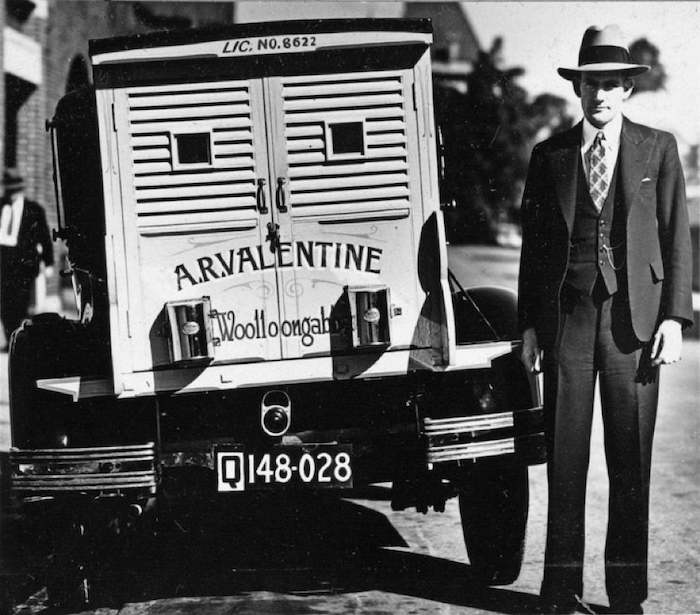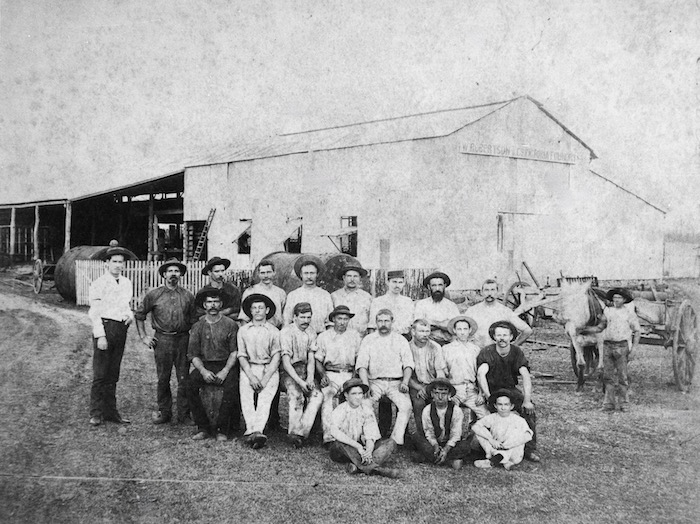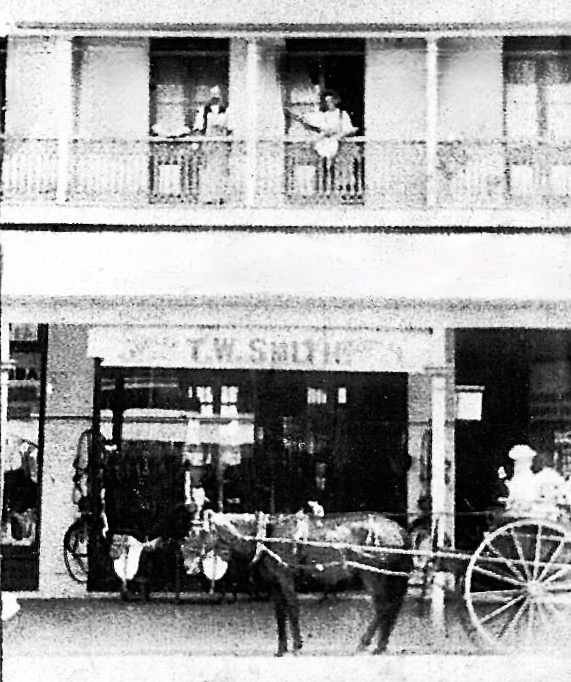Queensland Co-operative Boot Society, 1919

Factory workers outside the Boot factory in Annerley Road, Woolloongabba. The factory made boots and shoes for all the Services as well as the general public.
Butcher Shops in the 1900s
BUTCHER SHOPS in Brisbane in the 1900s were quite different from those of today. There were no ice boxes, cool rooms, marble surfaces or stainless steel benches. Meat carcasses would hang in the shop, meat was cut in front of customers on timber chopping blocks. Sawdust on the floor soaked up blood spills and odour. Often carcasses were hung outside at the front of the shop to allow fresh air to circulate. Butchers wore navy blue striped aprons , often with white shirts. William Ross’ Butcher Shop in Ipswich Rd, Woolloongabba, 1900. (SLQ 17649). Note the carcasses hanging outside to allow air to circulate. The butcher is wearing a traditional striped apron. Horse and cart delivery wagons are waiting outside.
William Ross’ Butcher Shop in Ipswich Rd, Woolloongabba, 1900. (SLQ 17649). Note the carcasses hanging outside to allow air to circulate. The butcher is wearing a traditional striped apron. Horse and cart delivery wagons are waiting outside.
During WWI and after (1915-1929) many butchers were taken over by the State to ensure fair pricing and availability for customers. By 1917 there were eighteen government-controlled butcher shops in Qld, eight of those in Brisbane, eventually rising to ninety in Qld.
This picture shows Watson and Son, Family Butchers in East Brisbane. Butchers are standing outside the shop wearing traditional striped aprons and white shirts while horse-drawn wagons are pulled up outside. The man in black could possibly be an inspector or owner.
The Chalk Hotel (former Railway Hotel)
The CHALK HOTEL (previously Railway Hotel & Recovery Hotel) 735 Stanley St, Woolloongabba, dates back to ca. 1889 when it was built for local businesswoman Mary Tynan. It was designed by prominent Brisbane architect Richard Gailey, who also designed the Regatta Hotel and other notable Brisbane buildings. Mary leased it to various publicans, including one James Kelly.
The original Railway Hotel about 1929. A three-story brick building with covered awning. It was built during the 1880-1892 hotel building boom when hotels became an important feature of Brisbane architecture.
Newspaper extract from The Week, Fri 19 Aug, 1892 announcing the bankruptcy of James Kelly, one of the most well-known licencees of the Railway Hotel.
The reasons given for his insolvency are strangely familiar: “heavy rental, depression of trade, removal of railway passenger traffic from Woolloongabba to Melbourne street, the hotel having been built expressly for that traffic.” Some things don’t change!
After Mary Tynan’s death in 1907 the property passed to the Fearron family and in 1918 it was bought by Castlemaine Brewery who owned it until 1976 when it passed into private hands and had several name changes.
After a major restoration in 2005 the Railways Hotel was renamed the Chalk Hotel which closed in 2015, but is expected to re-open at some stage after some major updates.
These chalk drawings on the ceiling of the covered entrance clearly show the Gabba and hotel theme and are still visible today.
Notice on the entrance wall announcing receivership. Apparently the hotel closed after ongoing disputes with the Brisbane City Council about noise. The Chalk’s partner hotel, Tempo, closed at the same time.
Hotel Timeline:
- 1889 Built for local businesswoman Mary Tynan, known as RAILWAY HOTEL
- ca 1958 underwent extensive alterations
- 1977 name changed to RECOVERY HOTEL
- 1990s name changed back to Railway Hotel
- 2005 major restoration – changed name to CHALK HOTEL
- 2014 placed in receivership – closed 10 Dec 2015
- ca 2020 ? expected to re-open as a developed site
Source: BCC Heritage Register: https://heritage.brisbane.qld.gov.au/heritage_register/
Clarence Corner and the Clarence Corner Hotel,
601 Stanley Street

Since the 1860s, the section of Stanley Street between Merton and Annerley Roads has been known as Clarence Corner.

The Clarence Hotel was established in 1863 in the days when Woolloongabba was still known as One Mile Swamp (the name was changed to Woolloongabba in the 1870s). It was a time of water holes, swamps and teams of bullock drays. In 1863 a builder called Thomas Hayselden saw a business opportunity and built a hotel to provide food and refreshments to the passing bullock teams coming from Ipswich along Boggo Road on the way to the South Brisbane wharves. In 1864 he transferred the licence to Richard Overend and built and ran the Albion Hotel after which the suburb was named.

In 1889 a new hotel called the Clarence Corner Hotel was built to replace the original hotel to cater for the residential and commercial district.

In 2010 the hotel was bought by Grant and Michelle Clark and renamed Brisbane Brewhouse, catering mainly for customers from the nearby Mater Hospital on opposite corners. It has been entered on the Brisbane Heritage Register. During a major restoration in 2016 significant historical elements of the building, such as the Victorian era façade, Flemish brickwork and wrought iron were kept intact.
Jewellery Businesses: Langford’s Jewellers
Langford’s Jewellers at the corner of Merton Road and Stanley Street in Woolloongabba appears to have been a very successful jewellery store, watchmaker and pawnshop in the early 1900s.




Jewellery Businesses: Blumberg Jewellers

Woolloongabba Bakers: John Martin’s Bakery, Stanley Street, ca. 1880.

The timber bakery building has a small balcony above the front awning and an oven chimney coming out of the roof at the left. There is a horse and cart outside, possibly the delivery cart, together with various other people; adults and children. (text and photo: SLQ).
Marie A. What a wonderful photo! How hard they all worked with wood stoves.
McDonald’s Cake Shop
Graham L. –This is a photo of the inside of the McDonalds Cake shop at the Gabba. This is the new shop as there was one there previously so I’m guessing this is late 50’s early 60’s or there about. My Aunt (my Grand Mother’s sister on my Mum’s side) worked at McDonalds at the Gabba and later on at their Stones Corner shop. It was a real treat to visit her at her work.
Corner Store corner Fleurs and Ross Streets, 1968


Ross P. Nice to see that the store is still there.
Melissa W. I agree. A lot of the buildings I grew up with are long gone. This little part of the Gabba is still mostly intact. My best friend lived in Park Rd, my sister lived in Merton Road and I still have a number of friends around these streets. I love this part of the Gabba as it reminds me of my childhood.
Gwenda M. I loved this shop, 1972 every weekend.
Nick B. For my Mum it was always a cup of tea, a Bex, and a good lie down.
Joy V. There was a butchers shop on left side in the 60’s. Used to unroll all our newspapers (separate sizes for the Telegraph and Courier) tie rolls in string, into the billy cart and off to the butcher. He weighed them and paid so much a lb.
Storm-damaged bakery 1905
 Clarence Corner and Murray Magee Drapers ca. 1906
Clarence Corner and Murray Magee Drapers ca. 1906

R. Lenehan’s Pharmacy – a Clarence Corner success story
Robert Lenehan was a highly regarded chemist located at 582 Stanley Street. He bought his first chemist shop from Thomason Chater Ltd in 1908.

The building was later demolished and replaced with the Lenehan Building.

The two-storey building is situated on a corner at the Fiveways. A wide verandah covers the footpath and advertising signs cover the edges of the verandah roof. One wall above the verandah advertises the Fiveways Pharmacy and also the Clarence, opposite Annerley Road. There are several people on the footpath including a young boy and two small children.
Robert Lenehan was highly regarded as a businessman and member of the local community. He built up a successful pharmacy business and was on the Pharmacy Board for some years. He also had an avid interest in sailing, bowls and the Masonic Lodge. He lived in a residence at the corner of Vulture and King Streets.

Photos and descriptions courtesy of State Library of Queensland.
Hillyard’s Shop House, 615 Stanley Street

This two-storey brick shop house was built ca. 1865 for Brisbane watchmaker George Hillyard who ran a family watchmaking and jewellery business. It is located in Stanley Street between Clarence Corner and Merton Road, next to what was then Pollock Shop House, also built around 1865. The business was on the ground floor with the upper floor residential. Originally there was an arched covered carriageway through to the back of the property, but this has since been enclosed to create another shop.
After …
Milk deliveries in the early days
The first forms of transport in the early days of the colony were bullock drays which could haul heavy loads across rough tracks. Pack horses and pack mules were also used. Once settlement increased and roads were formed, horses and waggons took over from the bullocks.
For many years local businesses delivered their goods by horse and cart and the sound of the clip clop of horses and the smell of their dung became an important part of daily life. Bread, milk, fruit and vegetables, and many general goods were delivered this way until the early 1970’s, although motorised vans already started make an appearance in the 1920s.
These photos of Mr A R Valentine and his milk van in Woolloongabba on 25 October 1937 are an example of how single-seater motor cars could be converted into milk delivery vans.


Australian National Hotel , 867 Stanley Street
The photo shows the ANA hotel as it looked in 1969. Today it is well-known as Dan Murphy’s liquor outlet.  ANA hotel 1969 (Brisbane City Council)
ANA hotel 1969 (Brisbane City Council)
Campbell M. – Aussie Nash, Rebels Bikers used to drink there and POW (Prince of Wales, Nundah).
Brian M. There was a car yard opposite on Stanley Street (can be seen in photo).The red-headed publican (ca. 1986) told me that the hotel opened in 1901 and that its name was a celebration of the federation of the Australian states. He said that there were original structures in the centre of the building, probably still there. There was an illegal massage parlour across Wellington Road and many of the girls who were employed there stayed in the upstairs rooms.
Barry T. Had a few in there!
Robin S. That was a great burger shop across the road too

Shell Spare Parts Shop, 11 Ipswich Road
The photo was taken on 17 June 1958. Note the tram lines and Chrysler car.

Frank Adlers store on Ipswich Road 1967

Marshall Drink Factory
Group photo of the staff outside the Marshall drinks factory. Note the water tanks on their side at the back and the man with a horse and dray filled with supplies.

Dand’s Fruit Depot
A lady and two children waiting outside Dand’s Fruit Depot in Ipwich Road in 1923.

T.W. Smith’s saddlery shop in Stanley Street, ca. 1900

This saddlery shop was run by Thomas William Smith (1869-1933), a pioneer farmer living in Hemmant. He was born on 2 June 1869 in Hemmant, Brisbane, where his father had settled in in 1864 and was educated at Hemmant State School. He became a pioneer farmer when the local farming lands were opened up. On 19 September 1895 he married Eliza Illingworth and they had five children.

In the early 1900s he had a saddlery business in Woolloongabba for about ten years, then went back into farming about 1910.
Thomas Smith was a highly- regarded member of his local community. A strongly religious man, he was a trustee of the Wynnum Methodist Church for about 15 years from its beginnings in 1902, and also trustee and treasurer of the Hemmant Methodist church.

He died suddenly at his home in Hemmant on 31 December 1933 at the age of 64. He was survived by his wife Eliza , his son, four daughters and seven grandchildren. His wife died on 4 May 1966 at the age of 90. (Sources: SLQ/WikiTree/Trove)
- W. Smith’s saddlery shop in Stanley Street, Woolloongabba ca. 1900
The word ‘saddler’ can just be read next to the company name. Photo quality is best available. (Flickr) -
Thomas W Smith ca 1909 at the time he had the saddlery shop in Woolloongabba. (WikiTree)
Woolloongabba Substation No. 5
Electrical Substation No. 5, now known as Woolloongabba Substation No 5, is located on the corner of Logan Road and Jurgens Street (originally Victoria Street, renamed Jurgens Street in the late 1880s). It is one of four 11 kV substations built in 1928 primarily to supply residential areas with electric light. It was developed by the City Electric Light Company Ltd, the first principal supplier of electricity in Brisbane.

Picture caption: The City Electric Light Company’s substation at Woolloongabba in 1926. In the foreground of the left can be seen the lightning arresters, and during a storm some pretty sights may be seen as the lightning passes to earth.

The brick and tile building was built in 1918 to a design by City Architect A H. Foster and extended in 1928. It was decommissioned in the late 1990s and is now listed on the Local Heritage Register.

Electrical substation No. 5, Woolloongabba. (Brisbane City Council Local Heritage Register) In 2015 Brisbane City Council put out expressions of interest for use of the station as a community art space. It is now a vibrant and popular community venue offering spaces for many uses such as community meetings, music performances, rehearsals, art gallery, pop-up shops, wedding venue, markets etc. The former substation is currently managed by Communify www.communify.org.au

Floorplan of the Woolloongabba Substation. (Brisbane City Council, 2015)  Woolloongabba’s beautifully renovated local heritage substation (1928) has concrete floors and exposed brick feature walls.
Woolloongabba’s beautifully renovated local heritage substation (1928) has concrete floors and exposed brick feature walls.
The Substation is perfect for a huge range of creative activities from art exhibitions, dance, drama, markets and small group activities.











